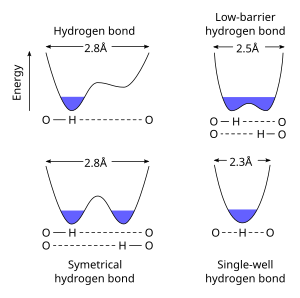Asymmetric hydrogen bondis a special type ofhydrogen bondin which theprotonis spaced exactly halfway between two identical atoms. The strength of the bond to each of those atoms is equal. It is an example of a3-center 4-electron bond.This type of bond is much stronger than "normal" hydrogen bonds, in fact, its strength is comparable to acovalent bond.It is seen in ice at high pressure (Ice X), and also in the solid phase of many anhydrousacidssuch ashydrofluoric acidandformic acidat high pressure. It is also seen in thebifluorideion [F−H−F]−.Much has been done to explain the symmetric hydrogen bond quantum-mechanically, as it seems to violate theduet rulefor the first shell: The proton is effectively surrounded by fourelectrons.Because of this problem, some consider it to be anionic bond.

References
edit- Steiner, Thomas (2002). "The Hydrogen Bond in the Solid State".Angewandte Chemie International Edition.41:48–76.doi:10.1002/1521-3773(20020104)41:1<48::AID-ANIE48>3.0.CO;2-U.PMID12491444.